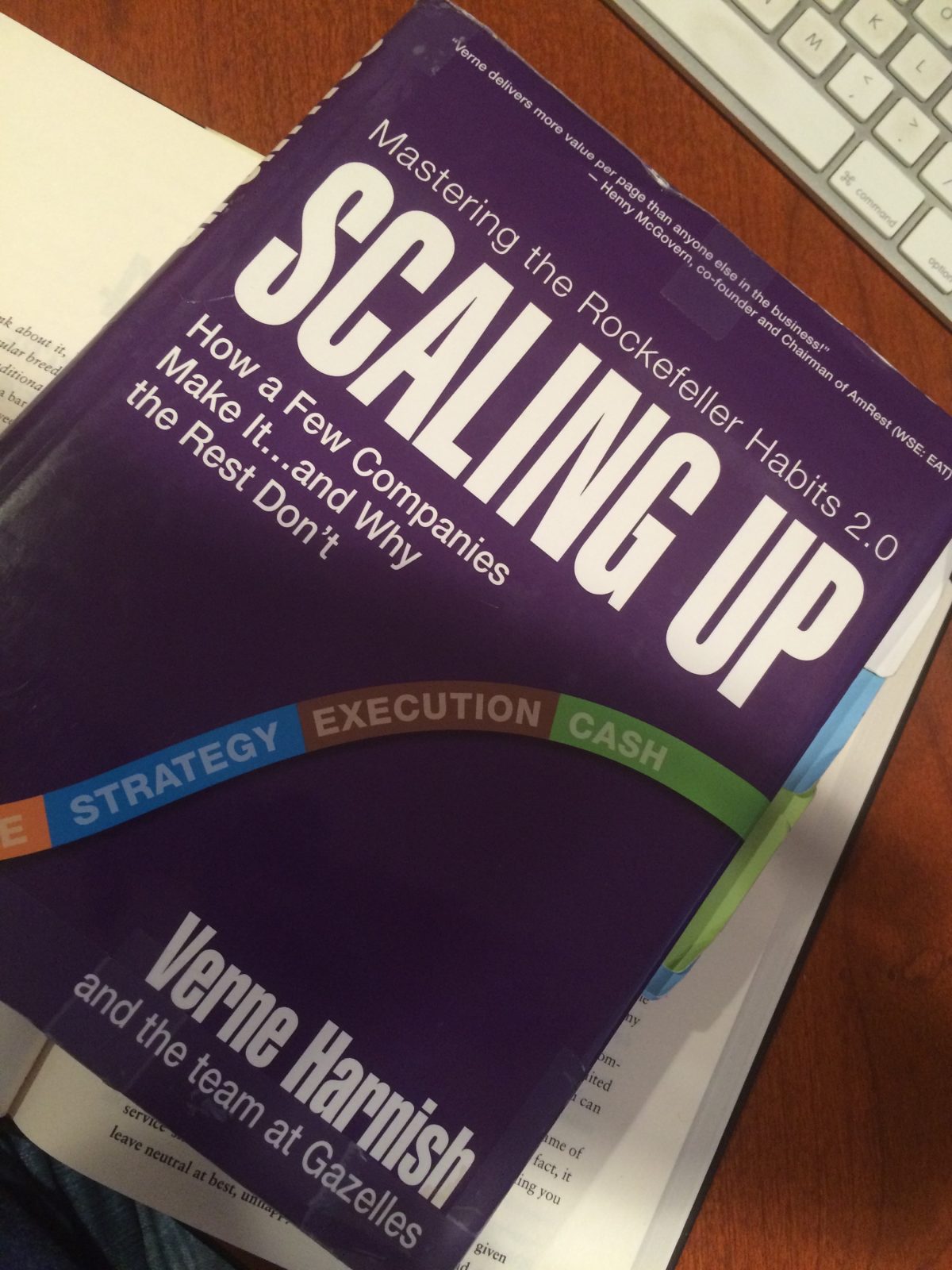Verne Harnish – Scaling Up: How a Few Companies Make It… and Why the Rest Don’t
Book Reviewed by Dian Byington, Ph. D.
This is not one of those books you’ll read from cover to cover while sipping a cup of coffee with your feet up on your desk. It’s more of a textbook, or a workbook, for CEOs and their executive teams to work through issues involved in scaling up their businesses. The first chapter is an executive summary, and the author describes its fast pace and many lists as “drinking from a fire hose!” It’s intense, so keep both feet on the floor. The ideas in the rest of the book are served up in more bite-sized pieces, although it never really slows down.
Harnish describes the keys to scaling up as: attracting and keeping the right people; creating a truly differentiated strategy; driving flawless execution; and having plenty of cash to weather the storms. Accordingly, there are sections devoted to each of these topics. Each section has at least three chapters and numerous worksheets to be completed. I think, if you work your way through the book, you’ll be happy you did.
The book is an update from the author’s first book, Mastering the Rockefeller Habits. The Rockefeller Habits are ten fundamental habits that support the successful execution of a strategy, and they haven’t changed for 100 years since John D. Rockefeller first implemented them.
Here are the first five:
- 1. The executive team is healthy and aligned.
- 2. Everyone is aligned with the #1 thing that needs to be accomplished this quarter to move the company forward.
- 3. Communication rhythm is established and information moves through the organization accurately and quickly.
- 4. Every facet of the organization has a person assigned with accountability for ensuring goals are met.
- 5. Ongoing employee input is collected to identify obstacles and opportunities.
Harnish spends quite a bit of time discussing how to ensure that the executive team is healthy and aligned. Essentially, the trick is to hire the best leaders; make sure everyone is on board with the organization’s Core Values, Purpose, and Competencies; execute without drama and with profitability; and have enough cash on hand to handle the hard times.
Harnish makes a big point of having every organization with which he consults institute a “daily huddle.” This is a 5- to 15-minute meeting to discuss tactical issues and provide updates. He says, “This will help you avoid minor train wrecks and take quick advantage of unforeseen opportunities. Normally, a daily huddle saves everyone an hour or so of needless email updates and ad hoc interruptions.”
Of course, there are other regular meetings besides the daily huddle: the weekly meeting, the monthly management meeting, and the quarterly annual planning meetings. The author discusses each meeting in detail and describes how and when it should take place, who should attend, and what should be covered in the agenda. This level of specificity could keep teams from getting trapped in perpetual meetings that waste time and resources.
In the daily huddle, for example, the agenda should be the same every day, and it’s just three items long, with five minutes maximum per item: 1. What’s up (in the next 24 hours)? 2. What are the daily metrics? 3. Where are you stuck?
The last part of the agenda is the most crucial. First, there’s something powerful in simply verbalizing your fears, your struggles, and your concerns. Second, you want to focus the team’s energy on breaking through constraints.
As a non-CEO, much of the book was difficult for me to understand. For example, the section on creating a strategic plan went into depth on filling out a complicated work sheet. The work sheet might be extremely helpful if you understand what is being asked and take the time fill in the blanks. But it doesn’t look easy. Strategic planning is one of the most complex and essential components of business, and if you get it right, your business is likely to thrive. If you can’t manage to complete the strategic plan from reading the book, Harnish’s company, Gazelles, is available to walk you through it.
The idea of helping companies scale up is a fascinating one. Harnish says, “To scale up a business from a handful of employees to something significant (i.e., build a company that has a chance to both put a “dent in the universe” and dominate its industry), our tools and techniques focus on three deliverables: Reduce by 80%, the time it takes the top team to manage the business (operational activities), Refocus the senior team on market-facing activities, and Realign everyone else (onto the same page) to drive execution and results.”
He goes on to describe four outcomes, three barriers, and four fundamentals. It’s challenging to hold all of these components in your mind at once. But, then, scaling up isn’t easy. If it were, every company would be able to do it. Harnish reminds us that a few companies will make it…while the rest don’t.
Scaling Up has won a number of awards, including the 2015 International Book Award for General Business. My recommendation: take a few minutes and give this book a look, and decide for yourself whether it’s worth taking the time to read it.

